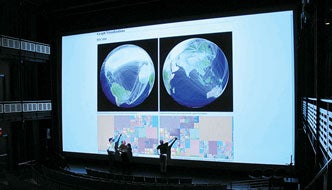
Rensselaer faculty and students use large-scale and collaborative visualization tools available at the Curtis R. Priem Experimental Media and Performing Arts Center to better understand and analyze large data sets.
U.S. News & World Report recently featured an op-ed by President Shirley Ann Jackson, titled “The New Polytechnic: Preparing to Lead in the Digital Economy,” in which she discussed a new way of working and learning that is required for success in this data-driven, computationally powered, globally networked era. She described changes underway at Rensselaer as a model to enable this future.
President Jackson’s vision for a “New Polytechnic” was incorporated as part of a U.S. News special report on the “Colleges of Tomorrow.” Six leaders, from some of the country’s top higher education institutions, offered their views on what the industry must do to thrive.
Pointing to the “extraordinarily rapid expansion in the creation, availability, and interconnectivity of data from multiple sources, and the ever more powerful analytical and computational capacity that is generating new information from this deluge of data,” President Jackson noted that there is a “a significant transformation globally in the way we make discoveries, make decisions, make products, make connections, and, ultimately, make progress. It is altering all aspects of curriculum and research at universities such as Rensselaer.”
“The ability to aggregate, integrate, validate, structure, and fully use the burgeoning mass of information available will define success in this data-driven future—including for universities,” she said.
Stronger collaborations are needed across disciplines, and sectors (universities, businesses and governments) and regions to link the capabilities of advanced information technologies, communications, and networking—to the life sciences, and the physical, materials, environmental, social, cognitive, and computational sciences, she wrote.

Rensselaer is incorporating data literacy across the curriculum, and throughout research and using digitally created immersive environments and multiplayer games, and artificially intelligent characters to teach and to learn. The Mandarin Project, housed in the Emergent Reality Lab, uses a game with a sustained storyline to teach Chinese language and culture. The students are characters in this game.
“We must harness the power of these tools and technologies to address the key intersecting challenges and opportunities of our time: in energy security, health, food, water, and national security, as well as the linked challenges of climate change and allocation of scarce resources so critical to our future,” she said.
It is imperative that the next generation is prepared to succeed and lead in this new world, she said. “Students need to acquire new skills for this digitally interconnected environment, including the ability to ‘translate’ between and among disciplines and sectors. They must learn to operate effectively and ethically in virtual communities, immersive environments, and in blended worlds.”
She pointed to a range of changes underway at Rensselaer to develop and use these new tools and technologies, so that our faculty and students can apply them to answer the great global challenges.
We must harness the power of these tools and technologies to address the key intersecting challenges and opportunities of our time: in energy security, health, food, water, and national security, as well as the linked challenges of climate change and allocation of scarce resources so critical to our future.”—President Shirley Ann Jackson
“We are incorporating data literacy across the curriculum, and throughout our research. We are using digitally created immersive environments and multiplayer games, and artificially intelligent characters to teach and to learn,” she said.
“We launched The Rensselaer Institute for Data Exploration and Applications—or The Rensselaer IDEA —bringing together talents and strengths in web science, high-performance computing, cognitive computing, data science and predictive analytics, and immersive technologies—and linking them to applications at the interface of engineering and the physical, life, and social sciences,” she said.
In addition, she noted that Rensselaer now has the most powerful university-based supercomputer at a private American academic institution; IBM’s Watson computer has enrolled at Rensselaer to expand its cognitive computing skills; a Rensselaer professor is leading the U.S. in a global effort—the Research Data Alliance—to enable scientists to access, combine, and preserve research data; and we have partnered with Mount Sinai’s Icahn School of Medicine to push the boundaries of data-driven health research.
“Interlinking all of these components and more, we are taking an interdisciplinary approach that will impact research and teaching in powerful new ways. We are educating our students—the next generation of discoverers, innovators, and entrepreneurs—to make a difference in this context. We are modeling the future,” she said.


